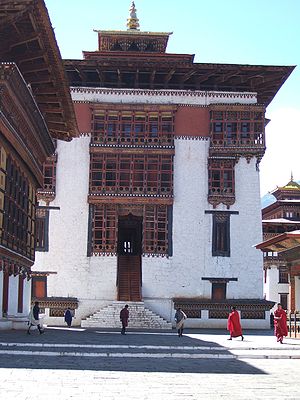
Tashichoedzong
Encyclopedia

Bhutan
Bhutan , officially the Kingdom of Bhutan, is a landlocked state in South Asia, located at the eastern end of the Himalayas and bordered to the south, east and west by the Republic of India and to the north by the People's Republic of China...
, on the western bank of the Wang Chu
Raidak River
The Raidak River is a tributary of the Brahmaputra River, and a trans-boundary river, flows through Bhutan, India and Bangladesh.-Bhutan:...
. It has traditionally been the seat of the Druk Desi
Druk Desi
The Druk Desi ;The original title is Dzongkha: སྡེ་སྲིད་ཕྱག་མཛོད་; Wylie: sde-srid phyag-mdzod. was the title of the secular rulers of Bhutan under the dual system of government between the seventeenth and nineteenth centuries...
(or "Dharma Raja"), the head of Bhutan's civil government, an office which has been combined with the kingship since the creation of the monarchy in 1907, and summer capital of the country.
- "It was built by the first Dharma Raja, who also founded the Lho-drukpa sect of Buddhism, which has remained the distinctive sect of Bhutan. The correct transliteration of the vernacular name—Bkrashis-chhos-rdzong, meaning "the fortress of auspicious doctrine"—is, according to Dr. Graham Sandberg, Tashichhoidzong...."
The main structure of the whitewashed building is two-storied with three-storied towers at each of the four corners topped by triple-tiered golden roofs. There is also a large central tower or utse.


In 1641 Shabdrung Ngawang Namgyal acquired it from Lama Phajo's descendants, but soon finding it too small, he built another one, known as the lower Dzong for the administration, keeping the older one for the monks. The original dzong was destroyed by fire in 1771 and everything was moved to the lower one which was expanded then, and again by the 13th Druk Desi (1744-1763), and also in 1866. It was damaged during an earthquake in 1897 and rebuilt in 1902. King Jigme Dorji Wangchuck had it completely renovated and enlarged over five years after he moved the capital to Thimpu in 1952 in traditional style using neither nails nor written plans.

Politics of Bhutan
The Government of Bhutan is a constitutional monarchy; between 1907 and the 1950s however, Bhutan was an absolute monarchy. The peaceful march to democracy has been a steady one. The King of Bhutan is head of state. Executive power is exercised by the Lhengye Zhungtshog, or council of ministers,...
since 1952 and presently houses the throne room and offices of the king, the secretariat and the ministries of home affairs and finance. Other government departments are housed in buildings nearby. West of the dzong is a small tower of Ney Khang Lhakhang which houses a statue of Shakyamuni Buddha and protective deities. In 1953 the royal family took up residence in the newly built Dechencholing Palace.
External links
- Tashichodzong
- Trashicho Dzong
- For a number of photos of Taschoedzong see: http://www.fotosearch.com/photos-images/tashichoedzong.html
- Also see: Trekearth.com

